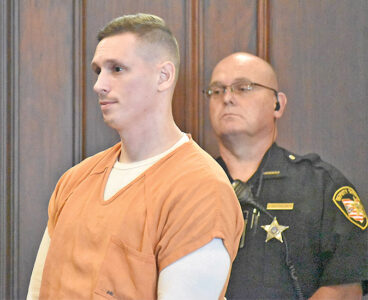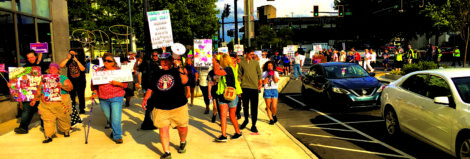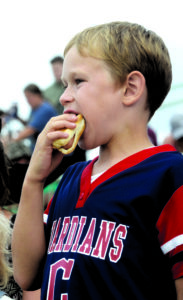Youngstown author journeys the world

EDITOR’S NOTE: This is one of a series of Saturday profiles of area residents and their stories. To suggest a profile, contact features editor Burton Cole at bcole@tribtoday.com.
YOUNGSTOWN — When Tom Welsh was 4 years old, his snowman picture had teachers at the Ursuline Preschool in Canfield thinking he was an artistic prodigy.
He said all the preschool students were given a test to determine their emotional and cognitive development. They were asked to complete a snowman figure drawn on paper. While other students added sticks for arms and legs, a nose and maybe some eyes, Welsh added a three-piece suit, top hat, a monocle and cane.
“The company the Ursuline nuns sent the tests to did not believe my picture was done by a 4-year-old, so they sent it back and had me redo it. This time, the snowman’s clothing was even more elaborate and I even had him standing on a plane, so he was kind of three-dimensional,” Welsh, 59, said.
Thus began his love for writing and drawing. Welsh, a native of Youngstown’s West Side, said he was writing and illustrating “books” when he was 5.
“But everything was misspelled. So if I was talking about a yellow boat, I wrote ‘yello bote’,” he said.
When he got to Ursuline High School, where he encountered a nun from the same community that ran his preschool, he was one of the few freshmen allowed to take art class.
MAKING A CHOICE
“I was a pretty talented draftsman, and people became more focused on my illustrations while my writing kind of flew under the radar,” Welsh said. “But to me, drawing and writing were two branches of the same river. I came from a family of Irish storytellers, which sparked my interest in local history and writing.”
He attended grade school at St. Brendan’s in his West Side neighborhood and then graduated from Ursuline in 1979. After graduation, he was told he couldn’t do anything with a liberal arts degree and he was pushed toward the creative arts, majoring in art at Youngstown State University and finding a niche as an illustrator for various publications.
“Despite the popularity at that time of graphic novels and comic books, I still felt as though I had to pick either arts or writing,” Welsh said.
After earning an art degree in 1986, he went back to YSU for a certificate in professional writing and editing when English professor Dr. Thomas Gay (who founded the YSU English Festival) recommended him for a graduate assistantship in the English department, which he did from 1991 to 1993.
“That is when I started leaning more toward writing. I became a correspondent for The Vindicator and wrote articles for the Metro Monthly. I eventually earned my master’s degree in English and language literature,” Welsh said, noting his master’s thesis was on northern Ireland poet John Montague.
OVERSEAS ADVENTURES
When his six-month contract as a correspondent at The Vindicator was up, he moved to Toledo, where his sister lived, and the two of them got involved in a sister city program that enabled participants to spend the summer of 1994 teaching English in Szeged, Hungary.
“Growing up on the West Side, I knew a lot of people of Eastern European descent, so I jumped at the opportunity,” Welsh said. He signed a writing contract with the Toledo Blade and one of the stipulations was that he had to write stories about his experiences in Hungary.
“Teaching there for those few months whetted my appetite for working overseas,” he said.
Someone recommended he teach in Poznan, Poland, but he kept hearing how others did that and came back with “nothing but the shirt on their backs.” Welsh said he realized going into debt was not a good idea at that point in his life. So he chose a different path and moved to Columbus, where his brother and sister-in-law lived.
Rather than take a job as a business writer for a Columbus newspaper, he applied to be an English teacher in South Korea and went there in the spring of 1995 to teach at a school in Taegu. He said there was an ancient Buddhist image known as Stone Hat and it was considered good luck for students to visit the site the night before their university entrance exams. He was invited to go on the pilgrimage that spring.
“I fell in love with Korea, and I loved teaching,” Welsh said.
But the journalism bug bit him again and he took an editing position at The Korea Herald based in Seoul.
The job afforded him opportunities to write and not just edit, and he started writing and illustrating a column on life in Korea. His first major story started out as a “fluff piece” on Korean Buddhism, and a scholar named Frank Tedesco invited him over for dinner. On his way there, Welsh saw a Buddhist temple burned to the ground and when he asked Tedesco about it, his new friend told him Christian fundamentalists were fire-bombing Buddhist temples and the mainstream Christian press was not covering it.
Welsh attended a press conference on the issue hosted by the country’s largest Buddhist sect, the Chogye Order, and his story was picked up by Reuters, as well as the BBC and the Tokyo bureau of the Independent, which credited Welsh as a source. Later, the largest Christian publication in Korea devoted an entire issue to the subject, which Welsh said reflected the impact of his coverage.
“That was definitely my proudest accomplishment. I broke that story just by taking a walk and asking questions,” Welsh said.
CHOOSING ACADEMIA
After three years in South Korea, he worked for a fledgling newspaper in Cambodia, the Cambodia Daily, where he spent one year. He returned to the United States in 2000 and found fewer newspaper opportunities than when he left, so he decided to pursue a career in academia.
“My grandmother was a teacher and my dad was a teacher, so there was a strong commitment to education in our family,” Welsh said.
He was a graduate assistant at Kent State University for three years, taught at KSU for one year and was a visiting scholar at YSU’s Center for Working Class Studies, where he met Dr. Sherry Linkon, who got him involved in the “Steel Valley Voices” project, for which he interviewed people of varying backgrounds for a history compilation.
Welsh earned his doctorate in Cultural Foundations of Education from KSU in May 2009 and his dissertation “Cross Purposes: Catholic Disunity and the Decline of Youngstown’s Parochial Schools, 1964-2006” became his first book “Closing Chapters: Urban Change, Religious Reform and the Decline of Youngstown’s Catholic Elementary Schools, 1960-2006.”
He co-authored three more books: “Strouss: Youngstown’s Dependable Store,” published in November 2012; “Classic Restaurants of Youngstown,” published in April 2014; and “A History of Jewish Youngstown and the Steel Valley,” published in May 2017.
His fifth book, on late developer William F. Cafaro, should be published next year.
Welsh is the oldest of four children born to Thomas Sr. and Elaine Casey Welsh. His sister, Susan, died in a car crash in 2012 that seriously injured his mother, who is now 88. His brother, Robert and his wife, Sapna, and his sister, Jeannette Welsh and her husband, Tony Dudzik, all live in Columbus. Their father died in 2010.
The family belonged to St. Brendan Church growing up, but they started attending St. Patrick Church on the city’s South Side in the 1980s, Welsh said.




